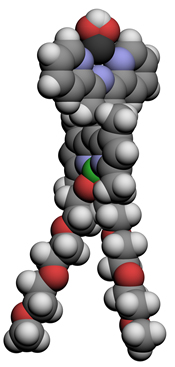A team of Bilkent and Hacettepe University researchers, led by Prof. Engin Umut Akkaya of the Department of Chemistry and the National Nanotechnology Research Center (UNAM), has published an article in the journal Nature Communications on a molecular demultiplexer that functions as a “terminator” automaton. But this tiny terminator is on our side: it kills cancer cells, then autonomously switches to another mode and sends out a light signal to confirm the death of the targeted cell.
Prof. Akkaya, a leading scientist in the field of molecular logic gates, and a recipient of the Czarnik Award for Molecular Sensors and Molecular Logic Gates (MSMLG), says that the current work is a successful integration of his previous work on advancing molecular logic gates and on radically transforming the photodynamic therapy of cancer. Other members of the research team are Dr. İlke Şimşek Turan and PhD student Seylan Ayan (both of Bilkent University), and Asst. Prof. Gürcan Günaydın (Hacettepe Department of Basic Oncology).
Work on therapeutic robots is often considered to be in the realm of engineering, and the expectation is that they will be produced by essentially miniaturizing what we already have in the macroscopic world. However, the promise of information-processing, molecule-sized objects implies much more than that; it offers substantial hope that this field of inquiry will bring about “disruptive” changes in the treatment of disease and the continuous monitoring of health.
 Such designer molecules with emergent properties fall within in the domain of science, primarily chemistry. The nano-sized automaton described in Prof. Akkaya’s article – a molecular entity that can autonomously switch between therapeutic and diagnostic modes as needed – is an example of the potential noted above. As related in the article, autonomous switching in cancer cell cultures was achieved by designing a molecular 1:2 demultiplexer with light at 488 nm as the primary input, cell membrane characteristics as the switch input, and cytotoxic singlet and light at 520 nm as the two alternative outputs.
Such designer molecules with emergent properties fall within in the domain of science, primarily chemistry. The nano-sized automaton described in Prof. Akkaya’s article – a molecular entity that can autonomously switch between therapeutic and diagnostic modes as needed – is an example of the potential noted above. As related in the article, autonomous switching in cancer cell cultures was achieved by designing a molecular 1:2 demultiplexer with light at 488 nm as the primary input, cell membrane characteristics as the switch input, and cytotoxic singlet and light at 520 nm as the two alternative outputs.
“We are pleased by the fact that our article has been published in one of the leading multidisciplinary science journals in the world, Nature Communications. However, more important is to insist on truly original and pathbreaking research. High-grade publications are then a natural consequence,” said Prof. Akkaya when asked about his latest article.
The open-access article is available online at the Nature Communications website:
https://www.nature.com/articles/s41467-018-03259-z.
More information on related research activities may be obtained from the Akkaya (EUA) Group website: http://euaresearch.com.